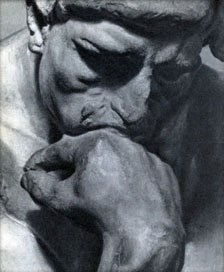Lessing Gotthold Ephraim (1729–81), German philosopher, critic, and literary figure whose philosophical and theological work aimed to replace the so-called possession of truth by a search for truth through public debate. The son of a Protestant minister, he studied theology but gave it up to take part in the literary debate between Gottsched and the Swiss Bodmer and Breitinger, which dealt with French classicism (Boileau) and English influences (Shakespeare for theater and Milton for poetry). His literary criticism (Briefe, die neueste Literatur betreffend [‘Letters on the New Literature’], 1759–65), his own dramatic works, and his theological-philosophical reflections were united in his conception of a practical Aufklärung, which opposed all philosophical or religious dogmatism. Lessing’s creation and direction of the National German Theater of Hamburg (1767–70) helped to form a sense of German national identity.
In 1750 Lessing published Thoughts on the Moravian Brothers, which contrasted religion as lived by this pietist community with the ecclesiastical institution. In 1753–54 he wrote a series of ‘rehabilitations’ (Rettugen) to show that the opposition between dogmas and heresies, between ‘truth’ and ‘error,’ was incompatible with living religious thought. This position had the seeds of a historical conception of religion that Lessing developed during his last years. In 1754 he again attempted a deductive formulation, inspired by Spinoza, of the fundamental truths of Christianity. Lessing rejected this rationalism, as substituting a dogma of reason for one of religion. To provoke public debate on the issue, be published H. S. Reimarus’s Fragments of an Anonymous Author (1774–78), which the Protestant hierarchy considered atheistic. The relativism and soft deism to which his arguments seemed to lead were transformed in his Education of Mankind (1780) into a historical theory of truth.
In Lessing’s view, all religions have an equal dignity, for none possesses ‘the’ truth; they represent only ethical and practical moments in the history of mankind. Revelation is assimilated into an education of mankind and God is compared to a teacher who reveals to man only what he is able to assimilate. This secularization of the history of salvation, in which God becomes immanent in the world, is called pantheism (‘the quarrel of pantheism’). For Lessing, Judaism and Christianity are the preliminary stages of a third gospel, the ‘Gospel of Reason.’ The Masonic Dialogues (1778) introduced this historical and practical conception of truth as a progress from ‘thinking by oneself’ to dialogue (‘thinking aloud with a friend’). In the literary domain Lessing broke with the culture of the baroque: against the giants and martyrs of baroque tragedy, he offered the tragedy of the bourgeois, with whom any spectator must be able to identify. After a poor first play in 1755 – Miss Sara Sampson – which only reflected the sentimentalism of the time, Lessing produced a model of the genre with Emilia Galotti (1781). The Hamburg Dramaturgy (1767– 68) was supposed to be influenced by Aristotle, but its union of fear and pity was greatly influenced by Moses Mendelssohn’s theory of ‘mixed sensations.’ Lessing’s entire aesthetics was based not on permanent ontological, religious, or moral rules, but on the spectator’s interest. In Laokoon (1766) he associated this aesthetics of reception with one of artistic production, i.e., a reflection on the means through which poetry and the plastic arts create this interest: the plastic arts by natural signs and poetry through the arbitrary signs that overcome their artificiality through the imitation not of nature but of action. Much like Winckelmann’s aesthetics, which influenced German classicism for a considerable time, Lessing’s aesthetics opposed the baroque, but for a theory of ideal beauty inspired by Plato it substituted a foundation of the beautiful in the agreement between producer and receptor. See also MENDELSSOH. G.Ra.
